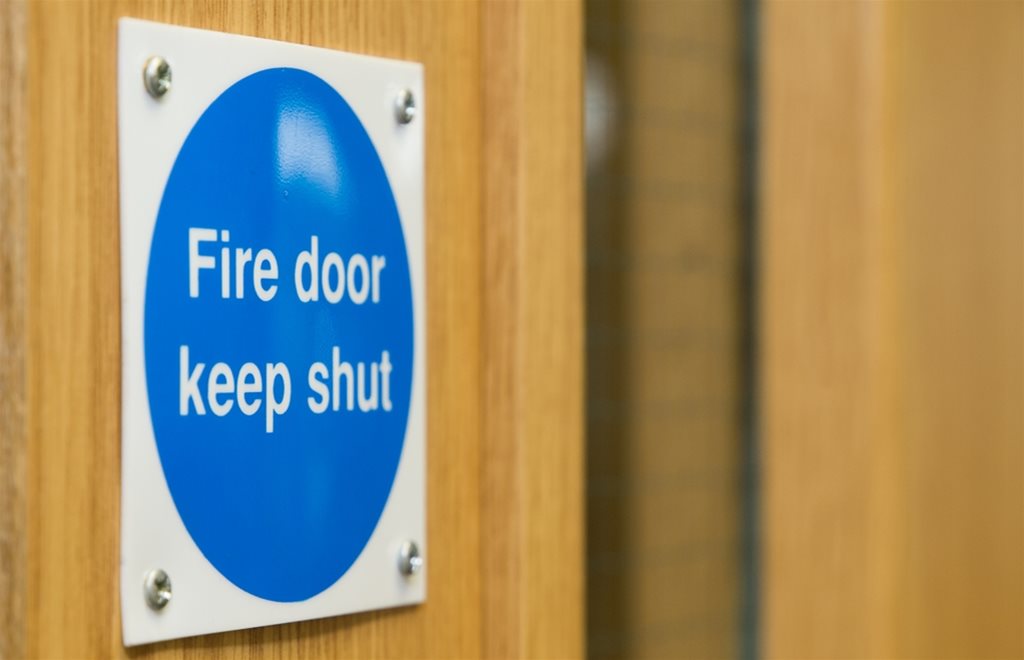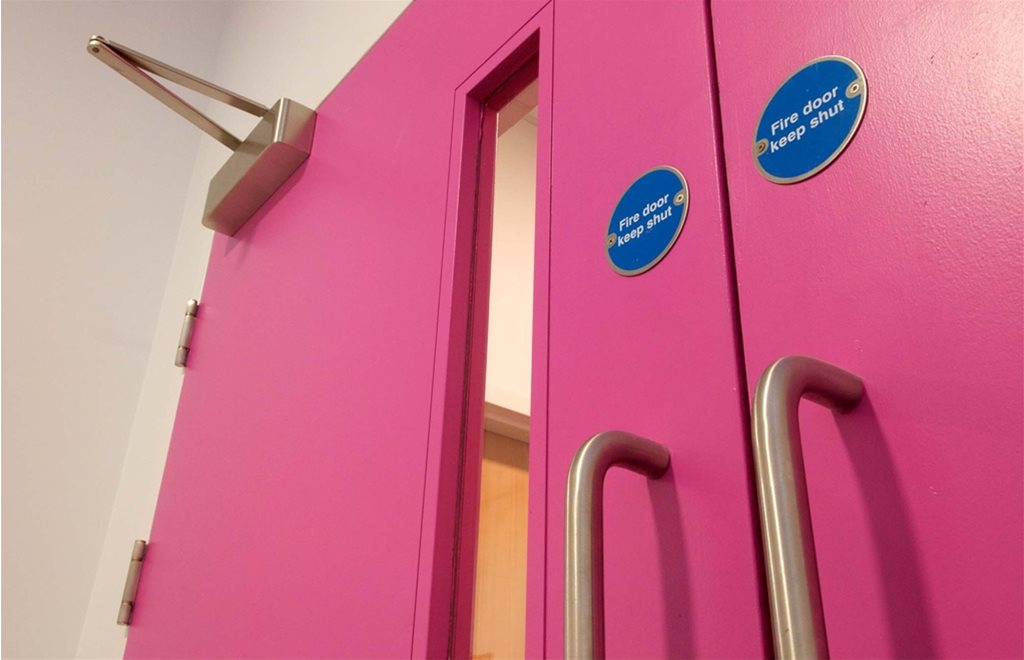Lee Perry spells out legal obligations to ensure building fire safety, in light of reported delays in fire door maintenance during the pandemic
STATISTICS HAVE revealed that over half of local authorities reported delays to fire door maintenance and inspection programmes since the start of 2020, with many citing the lockdown period due to the COVID-19 pandemic as the reason.
Correctly fitted and maintained fire doors (and the frames in which they sit) are critical to the safe evacuation of buildings where people live, work or visit. They form part of the compartmentation of the building and help to retain the fire in its area of origin, thus limiting the size and spread of a fire and controlling the perceived risk.
Every fire door is required to act as a barrier to the passage of smoke or fire for the period of time it has been certified to do so, depending upon its location within a building. Fire doors can often delay the spread of smoke and fire for a minimum of 30 minutes and up to one hour, allowing residents or employees ample time to find their escape route and vacate the premises.
A well designed timber fire door will also allow access to protected escape routes – both vertically and horizontally – without any loss of fire resistance, and will limit smoke movement in these routes, which include protected corridors, lobbies, stairways and shafts. Poorly fitted or damaged fire doors will result in smoke and heat seeping into the escape routes within the building, which makes it much more difficult to evacuate and puts lives needlessly at risk.
Fire and rescue services (FRSs) attended 153,957 fire incidents between March 2019 and March 20201 and, although this figure is decreasing year on year, it still demonstrates the vital importance of maintaining fire doors and regular, robust fire risk assessment reviews. Nevertheless, data gathered by the British Woodworking Federation (BWF) in 2020 found that, while around 26,318 residential fire doors were scheduled for maintenance or replacement between January and June of that year, work did not go ahead for 16,580 (63%) of them, affecting at least 9,954 homes.
Regulatory duties
Business owners, dutyholders and landlords are the responsible persons for fire safety in their properties and have a legal obligation to ensure that fire safety risk assessments are kept continuously up to date. This includes regular investigations of fire doors and escape routes.
As part of this, dutyholders must ensure that the door and frame – which are a fundamental part of the integrity of a fire door – meet the requirements of BS 476-22: 1987: Fire tests on building materials and structures. Method for determination of the fire resistance of non-loadbearing elements of construction; or of BS EN 1634-1: 2014 + A1: 2018: Fire resistance and smoke control tests for door and shutter assemblies, openable windows and elements of building hardware. Fire resistance test for door and shutter assemblies and openable windows.
In fire door testing, it is often the frame which accounts for the biggest rates of failure. Under the Regulatory Reform (Fire Safety) Order 2005 [FSO], employers and dutyholders in control of commercial premises must ensure the safety of employees as far as is reasonably practicable. They must also take reasonable precautions to protect the safety of other people in the building who are not in their employment.
The FSO also applies to all rented residential buildings, such as shared areas in houses in multiple occupation (HMOs), blocks of flats and maisonettes, but does not apply to individual private homes. In order to make sure that a rented property meets fire safety standards, a landlord must be able to demonstrate that a suitable and sufficient risk assessment has been carried out.
According to the requirements of the FSO, the person carrying out the risk assessment must be competent – that is, someone who has sufficient training and experience or knowledge to allow them to capably carry out the risk assessment. To ensure a high standard of assessment, many responsible people choose to appoint a third party certified risk assessor.
For landlords, compliance with the FSO will involve making sure communal areas such as landings, stairways and kitchens are kept clear of combustibles, to ensure that tenants can escape quickly and reduce the risk of fire in the escape routes. Practically, this can be hard to enforce because ultimately it is left to residents to follow these rules.
It is important therefore that landlords not only explain fire safety to their tenants, but also put something in writing to demonstrate that they have done their best to make their tenants aware of fire risk and their responsibilities.
The most effective way to comply with these regulations is to carry out periodic risk assessments. This acts as proof that all aspects of the property have been taken into consideration with regard to its effectiveness in preventing a fire from starting, warning tenants in the event that a fire does start and ensuring they have ample time to evacuate and a safe route to do so.
In March 2020, the Home Office introduced the Fire Safety Bill, which will amend the FSO to clarify that the responsible person or duty holder for multi occupied residential buildings must ‘manage and reduce the risk of fire’ posed by the building structure, external wall systems and entrance doors.
Under this clarification, FRSs will be authorised to take enforcement action and hold building owners to account if they are not compliant. The bill, which at the time of writing was going through parliament, will provide a firm foundation for building owners and managers of high rise and multi occupied residential buildings to understand their fire safety responsibilities, including ensuring that:
- where the building’s external walls have unsafe cladding, individual flat entrance doors comply with current standards
- there are regular inspections of lifts and reporting of results to the FRS
- evacuation plans are reviewed and regularly updated, and personal evacuation plans (PEEPs) are in place for residents whose ability to evacuate may be compromised
- fire safety instructions are provided to residents in a form they can be reasonably expected to understand

Delays reported
Despite the Fire Safety Bill further hammering home the roles of the responsible person regarding fire safety, a 2020 report revealed that over half of local authorities had not kept up with their fire door maintenance programmes in the first half of the year. As part of Fire Door Safety Week last September, the BWF and London Fire Brigade submitted a freedom of information request to all UK local authorities to gain insight into how they managed fire door maintenance in the first half of the year. Key results include:
- 60% of local authorities delayed fire door maintenance and inspection programmes in the first half of 2020
- 53% of local authorities cited COVID-19 as a reason for the delays
- more than 16,500 doors in almost 10,000 individual properties have been affected
- 63% of planned fire door maintenance and replacement works did not progress as scheduled
- 65% of those experiencing delays plan to recommence works by the end of 2020
These surprising results have some far reaching and potentially serious implications for those in local authority owned and managed housing in the UK. Understandably, the COVID-19 pandemic has been at the forefront of many minds since March 2020, and local authorities’ priorities will have been focused on keeping their areas safe and limiting the spread of the disease.
Another result of the pandemic is that, more than ever, businesses and local authorities are facing increased competition and pressure on their resources. Social distancing, increased hygiene and sanitisation and employees shielding are just some of the impacts that COVID-19 has had on businesses.
Quite naturally, fire safety inspections and assessments may take longer to carry out, and meeting best practice standards to protect fire and life safety may not always be easy. Those who might think fire safety can take a back seat during the pandemic should be aware that the fact many people are working or even confined to their homes will only raise more concerns for local authority housing associations.
With more people than ever staying at home, the importance of ensuring the safety of buildings is paramount. Delays to the fire door inspections and remedial actions that would follow those inspections is only putting residents more at risk should a fire occur. However, it was encouraging to see that 65% of local authorities had a plan to recommence fire door safety assessments before the end of 2020; albeit much work is required to clear the backlog of delayed inspections and ensure every home has safe and properly fitted fire doors.

Seeking help
Whatever the level of in house expertise, many providers exist that can assist businesses and local authorities by offering the benefit of their fire and life safety advice, and services such as fire risk assessments, testing, inspection and certification. As there is no ‘one size fits all’ solution to building fire safety management, though approaches may be similar, those services that are needed to help improve and manage fire safety in buildings can be selected and there is also the benefit of cost efficiencies from a combined service. Certain providers can offer fire door inspections and can act
as the responsible person to carry out a regular check of fire doors and monitor their condition for effective operation to mitigate both the risks posed by smoke and the risks of fire spread.
Ultimately, the responsible person must be confident that they have identified the fire precautions necessary to reduce risks to employees, visitors or tenants as far as reasonably practicable, and that these are implemented and work in practice. The key to that is a reasonable, realistic and achievable compliance strategy
Lee Perry is business manager at Bureau Veritas

Reference
- Fire and rescue incident statistics, England, year ending March 2020, Home Office, https://assets.publishing.service.gov.uk/government/uploads/system/uploads/attachment_data/file/908635/fire-and-rescue-incident-mar20-hosb2220.pdf